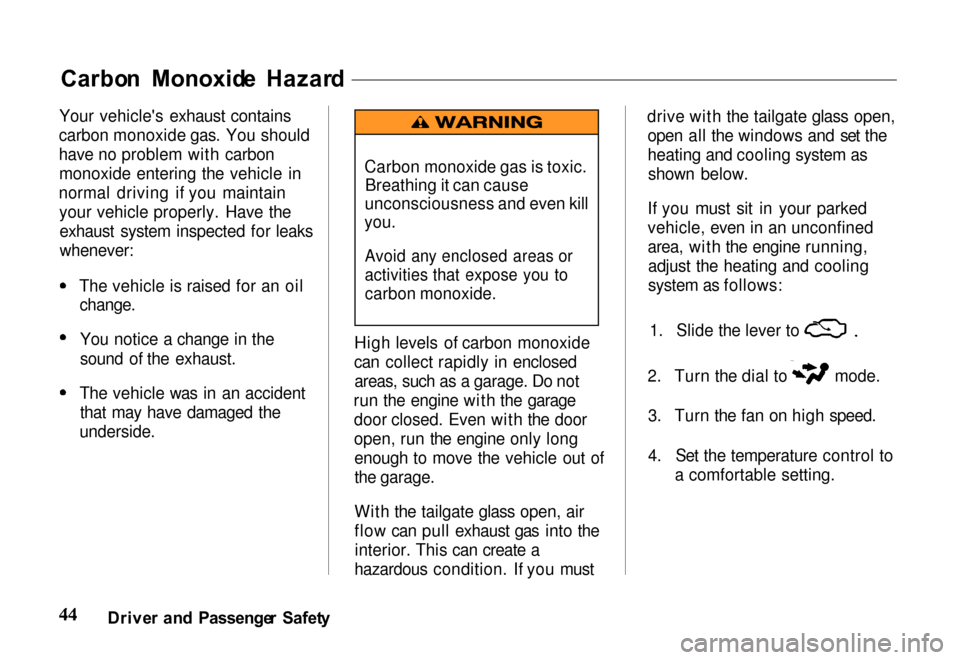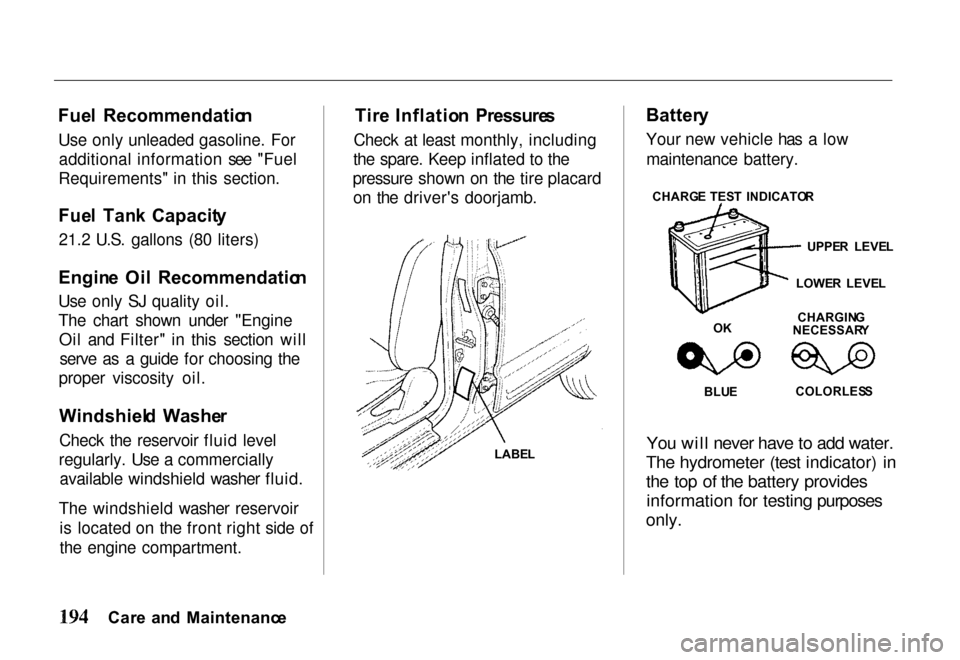Page 47 of 267

Carbo
n Monoxid e Hazar d
Your vehicle's exhaust contains
carbon monoxide gas. You should
have no problem with carbon monoxide entering the vehicle in
normal driving if you maintain your vehicle properly. Have theexhaust system inspected for leaks
whenever:
The vehicle is raised for an oil
change.
You notice a change in the
sound of the exhaust.
The vehicle was in an accident that may have damaged the
underside. High levels of carbon monoxide
can collect rapidly in enclosed areas, such as a garage. Do not
run the engine with the garage door closed. Even with the door
open, run the engine only longenough to move the vehicle out of
the garage.
With the tailgate glass open, air
flow can pull exhaust gas into theinterior. This can create a
hazardous condition. If you must drive with the tailgate glass open,
open all the windows and set the
heating and cooling system asshown below.
If you must sit in your parked
vehicle, even in an unconfined
area, with the engine running, adjust the heating and cooling
system as follows: 1. Slide the lever to
2. Turn the dial to mode.
3. Turn the fan on high speed.
4. Set the temperature control to a comfortable setting.
Driver an d Passenge r Safet y
Carbon monoxid
e gas is toxic.
Breathing it can cause
unconsciousness and even kill
you.
Avoid any enclosed areas or
activities that expose you to
carbon monoxide.
Page 54 of 267
Engin
e Compartmen t
P ENGINE OIL DIPSTICK
See page 196, 209.
Q WINDSHIELD WASHER
RESERVOIR
See page 69.
R RADIATOR CAP
See page 214.
P — ENGIN E OI L
DIPSTIC K
Q — WINDSHIEL D
WASHE R RESERVCH R
V — RADIATO R
RESERV E TAN K
S
ENGINE OIL FILL CAP
See page 208.
T BRAKE MASTER
CYLINDER
RESERVOIR
See page 215.
U CLUTCH MASTER
CYLINDER RESERVOIR
See page 219. V
RADIATOR RESERVE TANK
See page 214.
W POWER STEERING
RESERVOIR
See page 219.
X AIR CLEANER
See page 210.
T — BRAK E MASTE R
CYLINDE R RESERVOI R
U - CLUTC H MASTE R
CYLINDE R RESERVOI R
R — RADIATO R CA P
Off t o a Goo d Star t
S
— ENGIN E OI L FIL L CA P
W — POWE R STEERIN G
RESERVOI R
X — AIR CLEANE R
Page 66 of 267
the engine is started. If the light
fails to come on with the key
turned to the "ON" position, it
could indicate a burned out bulb
or a blown fuse. Have the system
repaired if the light does not come on when checking.
Occasionally, this light may
flicker momentarily while the
engine is running, but this will not
harm the system. However, if the light remains on during normal
engine operation, the engine should be stopped until the cause
of the trouble can be located and
corrected. The source of the
trouble could be either of the
following: Low engine oil level
Loss of engine oil pressure
Running the engine with low oil
pressure can cause serious mechanical damage almostimmediately. Turn off the engine
as soon as you can safely get the
vehicle stopped.
Instruments an d Control s
NOTIC
E
Page 71 of 267

Automati
c Transmissio n
Flui d Temperatur e Indicato r
The "A/T OIL TEMP" indicator
light warns that the automatic
transmission fluid temperature is
high.
The indicator light should turn onwhen the ignition switch is turned
to the "ON" position, but should
go out after a few seconds. If this light comes on while you are
driving, slow down and pull off the
road. Stop the vehicle at a safe
place and put the shift lever in "P"
position. With the engine idling,
wait until the light goes off. If thelight goes off, you can drive the
vehicle again. If the light does not
go off, have the automatic
transmission lubricating system
checked as soon as possible by
your Honda dealer.
Driving with the "AIT OIL TEMP" light constantly on will cause
serious mechanical damage to the
automatic transmission. Windshiel
d Wiper/Washe r
The lever on the right side of the steering column controls the
windshield wipers. Move the lever
down to select the various windshield wiper speeds.
In INT, the wipers operate every
few seconds. In LO and HIGH, the
wipers run continuously.
In INT, you can vary how often the
Instrument s an d Control s
Switche
s
NOTIC E
Page 189 of 267

Reverse this procedure to store
the spare tire. Connect the spare
tire to the bracket with the outside
of the wheel facing up. Make sure
the tire does not catch on any part
of the underbody of the vehicle as
you are raising it, and that the spare tire is stored securely before
driving.
If the engine overheats:
The engine coolant temperaturegauge pointer will move up to
the "H" or higher. Engine "ping" will become
excessive.
Loss of engine power will be
noticed.
Either steam or boiling water
will squirt out of the radiator.
If you find that the engine is
overheating:
Stop the vehicle, and turn on
the hazard warning lights.
If you see or hear steam or
coolant coming from the
engine compartment, turn off the engine immediately. If you do not see or hear steam
or spray, turn off the A/C (if
on) and run the engine at a
speed slightly higher than idle
speed (about 1,500 rpm) for
several minutes. Watch the
coolant temperature gauge. If it
remains at the ''H" mark, turn
off the engine.
Open the hood only after all
signs of steam or hot coolant
spray have stopped. Look for
signs of an obvious leak, such
as a split radiator hose. If you
I n Cas e o f Emergenc y
Steam and spray from an
overheated engine can
seriously scald you.
Do not open the hood if steam
is coming out.
Engin
e Overheatin g
Page 194 of 267

Car
e an d Maintenanc e
This section explains why it is important to keep your vehicle
well maintained and to follow
basic maintenance safety
precautions.
This section also includes Maintenance Schedules for
normal driving and severe driving
conditions, a Maintenance
Record, and instructions for simple maintenance tasks you
may want to take care of yourself.
If you have the skills and tools
required to perform more complex
maintenance tasks on your Honda,
you may want to purchase the Service Manual. See page 249 for
information on how to obtain a
copy, or see your Honda dealer. Service Station Information . 193
Fuel Fill Cap .......... 193Fuel Recommendation ... 194
Fuel Tank Capacity ..... 194
Engine Oil Recommendation ...... 194
Windshield Washer ..... 194
Tire Inflation Pressures .. 194 Battery ............... 194
Hood Release .......... 195
Engine Oil Dipstick ..... 196
Fuel Requirements ........ 196 Oxygenated Fuels ...... 196
Maintenance Safety ....... 197 Important Safety
Precautions .......... 198
Maintenance Schedule ..... 199
Required Maintenance Record 202
Owner Safety Checks ...... 204
Engine Oil and Filter ...... 207 Proper Quality Oil ...... 207 Change Interval ........ 207
Oil
Change ........... 208
Oil Filter Installation . 208
Oil Viscosity .......... 209
Oil Level Check ....... 209
Engine Oil Additives ... 210
Air Cleaner Filter ........ 210
Manual Transmission Fluid 211
Automatic Transmission Fluid .................. 212
Front (4WD) and Rear Axles ............. 212
Engine Cooling System ... 213
Other Required Maintenance 215 Brake Master Cylinder . . 215
Shift-on-the-Fly System
. 216
Front Whee
l Bearings ... 216
Hood Latch and Hinges . 217
Air Conditioning ....... 217 Body Lubrication ...... 217
Car e an d Maintenanc e
Page 197 of 267

Fue
l Recommendatio n
Use only unleaded gasoline. For additional information see "Fuel
Requirements" in this section.
Fue l Tan k Capacit y
21.2 U.S. gallons (80 liters)
Engin e Oi l Recommendatio n
Use only SJ quality oil.
The chart shown under "Engine Oil and Filter" in this section willserve as a guide for choosing the
proper viscosity oil.
Windshiel d Washe r
Check the reservoir fluid level
regularly. Use a commercially available windshield washer fluid.
The windshield washer reservoir is located on the front right side of
the engine compartment. Tir
e Inflatio n Pressure s
Check at least monthly, including
the spare. Keep inflated to the
pressure shown on the tire placard on the driver's doorjamb. Batter
y
Your new vehicle has a low maintenance battery.
You will never have to add water.
The hydrometer (test indicator) in
the top of the battery provides information for testing purposes
only.
Car e an d Maintenanc e LABE
L CHARG
E TES T INDICATO R
UPPE R LEVE L
LOWE R LEVE L
CHARGIN G
NECESSAR Y
BLU E COLORLES
S
O
K
Page 199 of 267

To Close
1. Lift the hood slightly to remove tension from the support rod.
2. Place the support rod in its retaining clip and lower the
hood.
Always make sure the hood is securely latched before you begin
driving.
Engin
e Oi l Dipstic k
Check the oil level when the
engine is off and the oil is warm, such as during a fuel stop. See
page 209. Your Honda operates most
effectively on unleaded gasoline with a pump octane number of 86
or higher. Use of a lower octane
gasoline can cause a persistent, heavy metallic rapping noise in
the engine that can lead to
mechanical damage.
We recommend gasolines containing
detergent additives that help prevent
fuel system and engine deposits.
Using gasoline containing lead will
damage your vehicle's emission
controls. This contributes to air
pollution and can void certain parts
of your warranty.
Oxygenate d Fuel s
Some conventional gasolines are
being blended with alcohol or an
ether compound. These gasolines are collectively referred to as
oxygenated fuels. To meet clean air
Car e an d Maintenanc e
Fue
l Requirement s